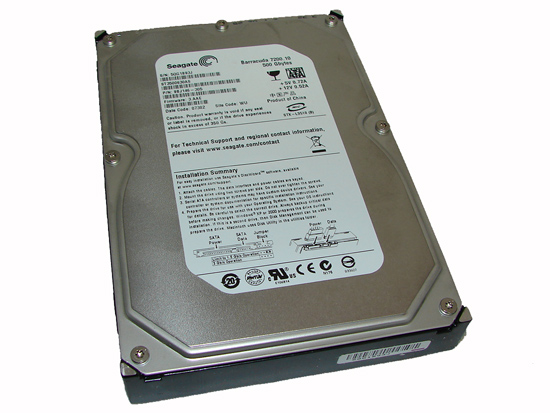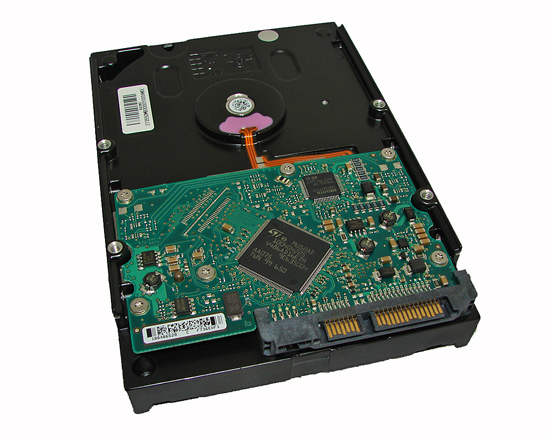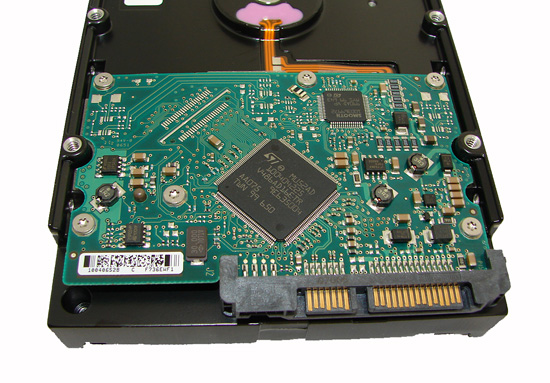Seagate 7200.10 500GB: Hitting the Sweet Spot
by Gary Key and Dave Robinet on July 6, 2007 11:00 PM EST- Posted in
- Storage
Feature Set: Seagate Barracuda 7200.10 500GB

The external casing design of the Seagate Barracuda 7200.10 series is basically unchanged from the previous generation 7200.9 series. The drive is based on the industry standard 3.5" form factor platform with pertinent part number and warranty information embossed on a white sticker on the top of the casing. However boring the exterior design may be, lurking under the plain casing is 500GB of storage capacity. Based upon the potential of perpendicular technology this same casing could be holding two terabytes of capacity within the next couple of years.

The 7200.10 SATA family ships with the Serial ATA data and power connectors only. There is no longer support for 4-pin Molex power connectors designed for use with older ATX power supplies. To the left of the data and power connectors is a 4-pin jumper block. This jumper block will determine whether the drive operates in Serial ATA/150 or Serial ATA-II/300 mode. Two pins are enabled by default, meaning the Seagate Barracuda 7200.10 ships and will operate in SATA/150 mode.
In order for the drive to operate in Serial ATA-II/300 mode, the jumper must be removed. Enabling SATA-II/300 is recommended if you have a compatible motherboard that fully supports SATA-II/300 operations. While this feature was advantageous for burst transfer rates in our synthetic benchmarks, overall we did not see any noticeable improvement in our real world benchmarks.

The PCB is openly visible on the bottom of the drive as in previous series and contains a ST Micro controller chip. The ST Micro Serial ATA controller chipset is standard for Seagate now after using the Agere chipset for some time.

The external casing design of the Seagate Barracuda 7200.10 series is basically unchanged from the previous generation 7200.9 series. The drive is based on the industry standard 3.5" form factor platform with pertinent part number and warranty information embossed on a white sticker on the top of the casing. However boring the exterior design may be, lurking under the plain casing is 500GB of storage capacity. Based upon the potential of perpendicular technology this same casing could be holding two terabytes of capacity within the next couple of years.

The 7200.10 SATA family ships with the Serial ATA data and power connectors only. There is no longer support for 4-pin Molex power connectors designed for use with older ATX power supplies. To the left of the data and power connectors is a 4-pin jumper block. This jumper block will determine whether the drive operates in Serial ATA/150 or Serial ATA-II/300 mode. Two pins are enabled by default, meaning the Seagate Barracuda 7200.10 ships and will operate in SATA/150 mode.
In order for the drive to operate in Serial ATA-II/300 mode, the jumper must be removed. Enabling SATA-II/300 is recommended if you have a compatible motherboard that fully supports SATA-II/300 operations. While this feature was advantageous for burst transfer rates in our synthetic benchmarks, overall we did not see any noticeable improvement in our real world benchmarks.

The PCB is openly visible on the bottom of the drive as in previous series and contains a ST Micro controller chip. The ST Micro Serial ATA controller chipset is standard for Seagate now after using the Agere chipset for some time.










19 Comments
View All Comments
VooDooAddict - Sunday, July 8, 2007 - link
Transfer performance differences of most drives seems negligible for single drive end users. Actual formated size, heat, warranty, noise, and the ever important price are the keys for end users.That isn't to say your performance numbers are useful. I'd almost bet that engineers from SAN manufactures like EqualLogic check out these reviews. When you have those performance differences amplified by running 14+ spindles it's a little more noticeable.
Kaleid - Sunday, July 8, 2007 - link
with platter density at record high 334GB.PenGun - Sunday, July 8, 2007 - link
You know some of us need to know how fast a drive writes. Any reason that information is not available? All these stupid unzip the file are just braindead.lopri - Saturday, July 7, 2007 - link
What is the theoretical advantage of 'perpendicular' design? Out of curiosity.TA152H - Sunday, July 8, 2007 - link
Better density.psychobriggsy - Saturday, July 7, 2007 - link
5 year warranty.'nuff said.
Although a 3 year warranty isn't so bad, but that last 10% of performance really doesn't excite me when it's regarding hard drives.
Yeah, yeah, I'm justifying my 320GB 7200.10 :p
JakeBlade - Saturday, July 7, 2007 - link
Sorry, that should be 1 out of 10. (Drank too much wine with my steak tonight).LoneWolf15 - Sunday, July 8, 2007 - link
Got any stats to back that up? If so, I'd love to see them. 10% within 10 months seems like an awfully high failure rate to me (unless you're talking about long-defunct brands like JTS and Kalok).JakeBlade - Saturday, July 7, 2007 - link
5 year, 10 year, 15 year warranty. When the drive is made dirt cheap from the disenfranchised workforce in China, any hard drive company can easily slap a warranty on anything that needs 1 out of every 25 replaced within 10 months, while still making a huge profit from cheap manufacturing costs. My source: Newegg -- 266 reviews, first ~25 from lowest rating report DOA/Failure.Golgatha - Monday, July 9, 2007 - link
sarcasmYes, I can't imagine that those who received a DOA hard drive or one that failed within a short period of time being a little miffed and taking their frustration out on the Newegg.com ratings boards.
/sarcasm